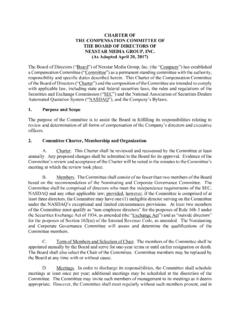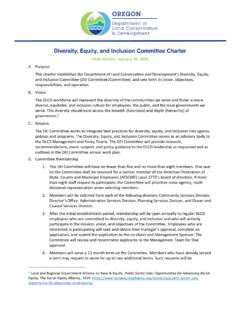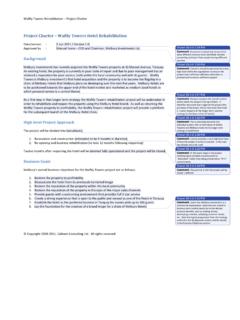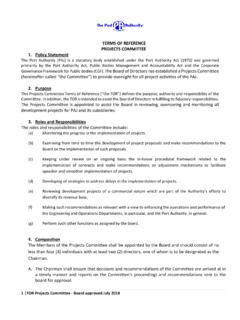Transcription of U.S. HOUSE OF REPRESENTATIVES COMMITTEE ON SCIENCE, …
1 1 HOUSE OF REPRESENTATIVES COMMITTEE ON SCIENCE, SPACE, AND TECHNOLOGY SUBCOMMITTEE ON RESEARCH AND TECHNOLOGY HEARING charter Strengthening the Microelectronics Workforce Tuesday, February 15, 2022 10:00 am 12:00 pm Zoom PURPOSE On Tuesday, February 15, 2022, the Subcommittee on Research and Technology of the COMMITTEE on Science, Space, and Technology will hold a hearing to understand the critical workforce needs of the microelectronic manufacturing sectors as part of the ongoing investments in increasing domestic production. The Subcommittee will examine current semiconductor workforce and training pipelines; explore gaps between current and future workforce needs; and discuss strategies to expand and diversify the microelectronics workforce.
2 WITNESSES Ms. Shari Liss, Executive Director, SEMI Foundation Dr. Osama Awadelkarim, UNESCO Chair Professor and Director of the Center for Nanotechnology Education and Utilization (CNEU), Pennsylvania State University Dr. Tsu-Jae King Liu, Dean and Roy W. Carlson Professor of Engineering, University of California, Berkeley OVERARCHING QUESTIONS What are the major challenges that have led to the workforce shortfall in the microelectronics industry? How can we raise awareness about microelectronics career opportunities across all levels of education? What are the effective pathways to prepare professionals for the workforce, including access to hands-on experiences and apprenticeships?
3 How can we increase diversity, equity, and inclusion within the semiconductor workforce? Where should Congress focus efforts workforce development efforts to meet the growing needs of the microelectronics manufacturing sector? 2 MICROELECTRONICS OVERVIEW Advanced microelectronics are a primary driver of economic growth and scientific advancement. These devices enable nearly everything in our modern lives from smartphones and cars to nuclear weaponry. Microelectronics is a term describing all aspects of the miniaturization of electronic circuits and components, from fundamental research to design to manufacturing. Semiconductors are a subset of microelectronics.
4 Most modern semiconductors are integrated circuits, also called chips , which are sets of miniaturized electronic circuits composed of active discrete devices ( , transistors), passive devices ( , capacitors), and their interconnections, all of which are layered on a thin wafer of semiconductor material ( , silicon). Semiconductor production includes three segments: (1) design, (2) manufacturing/fabrication, and (3) assembly, testing, and packaging (ATP).1 In some cases, these steps are all performed by a single company, called an integrated device manufacturer (IDM). Other semiconductor companies, called fabless firms, only do design in- HOUSE .
5 Fabless firms purchase fabrication services from a semiconductor factory and ATP services from an outsourced semiconductor assemble and test company. Additionally, the semiconductor production process requires several types of inputs, including materials, manufacturing equipment, software, and intellectual property, some of which is produced only outside of the United States. Microelectronics Manufacturing Capacity Went Abroad Over the last few decades, much of the microelectronics manufacturing capacity has been offshored. The share of global semiconductor manufacturing decreased from 37 percent in 1990 to just 12 percent This occurred in part because it became cheaper to fabricate semiconductors abroad, and many semiconductor companies moved these labor-intensive elements of their supply chain to Asia.
6 For example, Taiwan accounts for 47 percent of the global capacity to manufacture advanced logic semiconductors, such as those used in smart phones or data Other companies simply stopped manufacturing semiconductors themselves, becoming fabless design companies. With the decrease in manufacturing came a subsequent loss of the semiconductor workforce, especially the technical workforce. Today, many countries in Asia have a competitive advantage over the United States in terms of high-skilled workforce capacity for semiconductor manufacturing. This lack of available technical workers is part of the reason that the United States does not have a single state-of-the-art fab capable of making the most advanced microelectronics.
7 Efforts to expand and diversify the microelectronics workforce will be a critical piece of the effort to bring microelectronics manufacturing back to the United States. 1 Micha ela Pla tzer et al., Semiconductors: Industry, Global Competition, and Federal Policy, Congressional Resea rch Service, October 26, 2020. 2 Antonio Varas et al., Government Incentives and Competitiveness in Semiconductor Manufacturing, Semiconductor Industry Association, September 2020. 3 Varas et al., Government Incentives and Competitiveness in Semiconductor Manufacturing. 3 SEMICONDUCTOR JOB TYPES AND PIPELINES The American semiconductor industry employs an estimated 277,000 people in a wide range of technical jobs with unique skills and educational Although there is significant breadth across employers and technology sectors, it is useful to segment jobs into the following categories to understand the broader education and workforce training strategies.
8 Production - Comprising 38% of semiconductor sector jobs this category includes line workers and factory While training is very specific to the job, positions may often require technical coursework including fundamental mathematics and physics. Training for production occupations may be well suited to certificate and associate degree programs at community and technical colleges, apprenticeships, or other on the job training. Examples of this job include assemblers, fabricators, maintenance, and repair workers. Production employees are able to easily move jobs between companies as well as to adjacent sectors, such as battery or solar Engineering Making up 24% of jobs in the industry this category includes engineers, software developers, research staff, and chip designers.
9 Employees in this category typically hold a bachelor s degree or higher in electrical or computer engineering. R&D and design staff typically have advanced degrees with experience in academic research. Highly skilled staff may also have degrees in other physical and mathematical disciplines. Employees in this sector, especially those with advanced technical skills, like data science and artificial intelligence, are highly sought by companies and are able to easily move throughout the semiconductor industry. Management, sales, and business operations This group comprises all other aspects of semiconductor operations. Industry specific training typically occurs on the job, though employees with knowledge of the field are able to move between companies.
10 WORKFORCE DEMOGRAPHICS To successfully grow domestic microelectronics manufacturing, the field will need to successfully attract, train, and retain a large and diverse workforce. In comparison to other sectors, the semiconductor industry currently lags in employing Black and Hispanic men, and women of all races and ethnicities. In 2021, the Semiconductor Industry Association (SIA) reported that Black employees held 4% of all jobs in the semiconductor workforce, compared to 10% and 12% of all manufacturing fields and all employment sectors Similarly, Hispanic employees made up 13% of the workforce compared to 17% and 18% of the same categories.









